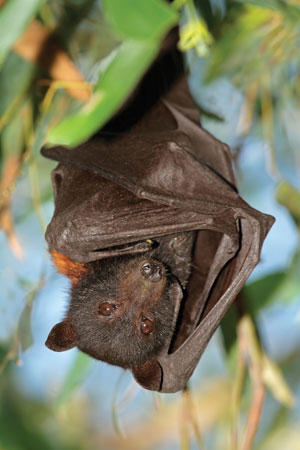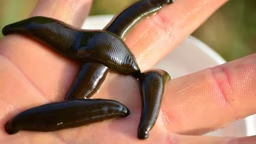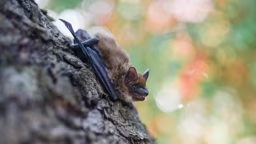Bats have somehow become associated with Halloween, full moons and legends of vampires. Scenes such as these evoke fear and misundertandings that have plagued bats for centuries. But nothing could be further from the truth.
Bats are actually gentle, timid mammals; they are not blind; they do not tangle themselves in human hair; most do not carry diseases and only vampire bats (found in South and Central America) drink blood. At last, it is now recognized that bats are valuable animals – especially if you’re a cabin owner plagued by pesky insects! It is imperative that we understand the unique role that bats play in many ecosystems and work diligently to protect them from the very real possibility of extinction.
Bats are actually gentle, timid mammals; they are not blind; they do not tangle themselves in human hair; most do not carry diseases and only vampire bats (found in South and Central America) drink blood. At last, it is now recognized that bats are valuable animals – especially if you’re a cabin owner plagued by pesky insects! It is imperative that we understand the unique role that bats play in many ecosystems and work diligently to protect them from the very real possibility of extinction.
The Amazing Flying Mammal
Bats are one of the most unique and exciting animals in the world. Since they are the only true flying mammals, they are put into their very own scientific order:
Chiroptera, meaning “hand-wing.” There are currently 1,115 different kinds of bats in the world, making up nearly 25 percent of the living mammal species on Earth. They are as diverse as the tiny hognose bat of Thailand (weighing no more than a dime) to the Malayan flying fox with a 6-foot wingspan. There are bats that eat fish, frogs, birds, blood, insects, fruit, and much more.
Throughout the tropics, bats are important pollinators and spread seeds of hundreds of plants including agave (thank bats if you like tequila!), bananas, mango and durian. Scientists have also derived medicines from bats, including anti-clotting agents in vampire bat saliva.
Bats are one of the most unique and exciting animals in the world. Since they are the only true flying mammals, they are put into their very own scientific order:
Chiroptera, meaning “hand-wing.” There are currently 1,115 different kinds of bats in the world, making up nearly 25 percent of the living mammal species on Earth. They are as diverse as the tiny hognose bat of Thailand (weighing no more than a dime) to the Malayan flying fox with a 6-foot wingspan. There are bats that eat fish, frogs, birds, blood, insects, fruit, and much more.
Throughout the tropics, bats are important pollinators and spread seeds of hundreds of plants including agave (thank bats if you like tequila!), bananas, mango and durian. Scientists have also derived medicines from bats, including anti-clotting agents in vampire bat saliva.
Bye-bye Bugs
In the United States and Canada, there are about 45 species of bats. Most eat insects. In fact, bats are the primary predators of insects that are active at night. Insects such as flies, gnats and mosquitoes are consumed every evening. More importantly, agricultural crop pests such as leafhoppers, cucumber beetles, June bugs, emerald ash borers, noctuid moths, and other crop-damaging pests are voraciously devoured. In a recent study published in Science magazine, it was estimated that bats in the United States provide $22.9 billion in agricultural crop pest control. Studies have also shown that bats eat far more insects than birds do in most ecosystems.
Because insect-eating bats dramatically reduce pests, this can reduce our use of pesticides. One little brown bat can eat thousands of insects each night; a colony of millions of free-tailed bats can eat billions of bugs a night. That means our water, air and soil stay healthy, thereby protecting all wildlife. And, with less money spent on pesticides, our food is healthier and costs less. With fewer bats, insect populations would most likely explode, increasing our dependence on toxic chemicals and driving up the cost of food production.
In the United States and Canada, there are about 45 species of bats. Most eat insects. In fact, bats are the primary predators of insects that are active at night. Insects such as flies, gnats and mosquitoes are consumed every evening. More importantly, agricultural crop pests such as leafhoppers, cucumber beetles, June bugs, emerald ash borers, noctuid moths, and other crop-damaging pests are voraciously devoured. In a recent study published in Science magazine, it was estimated that bats in the United States provide $22.9 billion in agricultural crop pest control. Studies have also shown that bats eat far more insects than birds do in most ecosystems.
Because insect-eating bats dramatically reduce pests, this can reduce our use of pesticides. One little brown bat can eat thousands of insects each night; a colony of millions of free-tailed bats can eat billions of bugs a night. That means our water, air and soil stay healthy, thereby protecting all wildlife. And, with less money spent on pesticides, our food is healthier and costs less. With fewer bats, insect populations would most likely explode, increasing our dependence on toxic chemicals and driving up the cost of food production.
Threatened & Endangered
Unfortunately, nearly 50 percent of bat species in the world are either threatened or endangered. Much of the decline is due to habitat loss, pollution and years of a rotten (and undeserved) reputation.
Today’s immediate crisis for bats is “white nose syndrome,” an invasive cold-loving fungus that awakens bats while they hibernate. Over a million bats have died from this fungus since its first citing in 2006, causing starvation due to their increased sleep disturbances.
Unfortunately, nearly 50 percent of bat species in the world are either threatened or endangered. Much of the decline is due to habitat loss, pollution and years of a rotten (and undeserved) reputation.
Today’s immediate crisis for bats is “white nose syndrome,” an invasive cold-loving fungus that awakens bats while they hibernate. Over a million bats have died from this fungus since its first citing in 2006, causing starvation due to their increased sleep disturbances.
The Battle to Save Bats
There are many things that you can do to help bats:
Implement organic gardening techniques in your backyard to reduce the impact of potential chemical poisoning of bats, as well as other wildlife.
Work to educate your friends and neighbors about the important role bats play in the ecosystem.
Plant wildlife gardens on your property, provide preferred bat habitats like bat houses, and protect caves and abandoned mines from human disturbance.
Bat habitats are declining throughout the world and especially here in the United States. Bats enjoy roosting in dead and dying trees found in wetland areas. However, America’s wetlands are being destroyed, leaving fewer places for bats to roost. Properly-made bat houses give bats an alternative place to live, not to mention the benefits we receive from our guests!
Research conducted by the Organization for Bat Conservation shows that if bat houses are designed to certain specifications and mounted properly, chances of successfully attracting bats are great. A bat house should be long and wide (at least 14 inches wide and 24 inches tall), allowing for temperature variation and room to raise young. The opening at the bottom should be ¾ of an inch and a landing area should extend below. The inside should be lined with plastic mesh or have grooves to help the bats hang on, and the entire bat house should be caulked to prevent drafts. The setting is also key: mount the house at least 15 feet off the ground on a pole, dead tree or side of building; face the bat house south or southeast toward an open setting; and paint the bat house with dark-color exterior latex paint to absorb the sun’s heat.
There are many things that you can do to help bats:
Implement organic gardening techniques in your backyard to reduce the impact of potential chemical poisoning of bats, as well as other wildlife.
Work to educate your friends and neighbors about the important role bats play in the ecosystem.
Plant wildlife gardens on your property, provide preferred bat habitats like bat houses, and protect caves and abandoned mines from human disturbance.
Bat habitats are declining throughout the world and especially here in the United States. Bats enjoy roosting in dead and dying trees found in wetland areas. However, America’s wetlands are being destroyed, leaving fewer places for bats to roost. Properly-made bat houses give bats an alternative place to live, not to mention the benefits we receive from our guests!
Research conducted by the Organization for Bat Conservation shows that if bat houses are designed to certain specifications and mounted properly, chances of successfully attracting bats are great. A bat house should be long and wide (at least 14 inches wide and 24 inches tall), allowing for temperature variation and room to raise young. The opening at the bottom should be ¾ of an inch and a landing area should extend below. The inside should be lined with plastic mesh or have grooves to help the bats hang on, and the entire bat house should be caulked to prevent drafts. The setting is also key: mount the house at least 15 feet off the ground on a pole, dead tree or side of building; face the bat house south or southeast toward an open setting; and paint the bat house with dark-color exterior latex paint to absorb the sun’s heat.
Bat populations are in need of your help. While it may be fun to shriek at spooky images of bats during Halloween, bats really are crucial allies. Without them, farmers will need to rely on more expensive and toxic methods to protect their crops and we – the consumer – will pay more to enjoy the fruits of their labor.
Rob Mies, Co-founder and Director of the Organization for Bat Conservation’s Bat Zone at Cranbrook Institute of Science, is the author of many articles and books about bats, including Stokes Beginner’s Guide to Bats.
READER RESOURCE: For more information about bats, bat houses, bats in the home and bat conservation go to www.batconservation.org.
Rob Mies, Co-founder and Director of the Organization for Bat Conservation’s Bat Zone at Cranbrook Institute of Science, is the author of many articles and books about bats, including Stokes Beginner’s Guide to Bats.
READER RESOURCE: For more information about bats, bat houses, bats in the home and bat conservation go to www.batconservation.org.
ABOUT BATS
The scientific order that bats belong to is called “Chiroptera,” meaning hand-wing.
Worldwide, there are 1,115 different species of bats, most of which live in tropical regions.
There are 45 different species of bats that live in the United States and Canada.
The most common species is the big brown bat.
Mega-Bats (also called "flying foxes") are large fruit bats found in the rainforests of Australia, Asia and Africa. They have large eyes, small ears, large bodies and have a dog-like face.
Micro-Bats are small bats found all over the world. They have large ears, small eyes, small bodies and use echolocation (like sonar and radar) to find their food. They eat a wide range of food including insects, fruit, nectar or frogs and some even eat fish, birds and other bats.
Most bats are colonial. They often live in dead trees, caves, bat houses, human structures and rock crevices. Some bats are solitary, mainly living in live trees.
BAT HOUSE BASICS
Bat houses should be tall, wide and have thin chambers.
Use cedar or exterior plywood, decking screws and caulk.
Place the bat house at least 15 feet off the ground, facing an open sunny location.
Cover with dark exterior latex paint or stain to seal the bat house and absorb heat.
Mount on a pole, building or dead tree for best results.
The scientific order that bats belong to is called “Chiroptera,” meaning hand-wing.
Worldwide, there are 1,115 different species of bats, most of which live in tropical regions.
There are 45 different species of bats that live in the United States and Canada.
The most common species is the big brown bat.
Mega-Bats (also called "flying foxes") are large fruit bats found in the rainforests of Australia, Asia and Africa. They have large eyes, small ears, large bodies and have a dog-like face.
Micro-Bats are small bats found all over the world. They have large ears, small eyes, small bodies and use echolocation (like sonar and radar) to find their food. They eat a wide range of food including insects, fruit, nectar or frogs and some even eat fish, birds and other bats.
Most bats are colonial. They often live in dead trees, caves, bat houses, human structures and rock crevices. Some bats are solitary, mainly living in live trees.
BAT HOUSE BASICS
Bat houses should be tall, wide and have thin chambers.
Use cedar or exterior plywood, decking screws and caulk.
Place the bat house at least 15 feet off the ground, facing an open sunny location.
Cover with dark exterior latex paint or stain to seal the bat house and absorb heat.
Mount on a pole, building or dead tree for best results.
WHAT TO DO IF A BAT GETS IN THE HOUSE
If a bat is found in the house, simply let the bat fly out an open door or window. If it does not fly out, put on a pair of thick leather gloves and use a bucket or box to scoop up the bat and take it outside. Take care when handling bats, because like any wild animal, they may bite in self-defense. If bitten, put a box over the bat and immediately contact public health officials. To 'evict' bats from your house, watch the house at sunset to see where they come out. Place a one-way exit (see October 2010 issue) over the spot where the bat left and leave it up for one week to ensure all the bats are gone. However, this procedure should not be done in the winter (when bats may be hibernating) or in the summer (when flightless baby bats are present).
If a bat is found in the house, simply let the bat fly out an open door or window. If it does not fly out, put on a pair of thick leather gloves and use a bucket or box to scoop up the bat and take it outside. Take care when handling bats, because like any wild animal, they may bite in self-defense. If bitten, put a box over the bat and immediately contact public health officials. To 'evict' bats from your house, watch the house at sunset to see where they come out. Place a one-way exit (see October 2010 issue) over the spot where the bat left and leave it up for one week to ensure all the bats are gone. However, this procedure should not be done in the winter (when bats may be hibernating) or in the summer (when flightless baby bats are present).
MYTH BUSTERS
Bats are not blind. In fact, some bats have keen eyesight like an owl.
Vampire bats do not live in the U.S. or Canada. They live in southern Mexico and Central and South America and feed primarily on cows.
Bats do not get tangled in human hair or trapped in people's clothing. They are very adept and agile flyers.
Bats do not attack humans. Humans attract insects, So bats sometimes fly near humans in search of a meal.
All bats do not have rabies. Actually, very few bats in the United States and Canada ever contract rabies.
Bats are not blind. In fact, some bats have keen eyesight like an owl.
Vampire bats do not live in the U.S. or Canada. They live in southern Mexico and Central and South America and feed primarily on cows.
Bats do not get tangled in human hair or trapped in people's clothing. They are very adept and agile flyers.
Bats do not attack humans. Humans attract insects, So bats sometimes fly near humans in search of a meal.
All bats do not have rabies. Actually, very few bats in the United States and Canada ever contract rabies.
HOW BIG ARE BATS?
The biggest bat in the world is the Malayan flying fox found in Asia. It weighs about 2 pounds and has a wingspan of about 6 feet.
The smallest bat in the world is the bumblebee bat (officially known as the Kitti's hog-nosed bat). It is found in Thailand and weighs about 2 grams (as much as a dime). It has a 6-inch wingspan.
The biggest bat in the world is the Malayan flying fox found in Asia. It weighs about 2 pounds and has a wingspan of about 6 feet.
The smallest bat in the world is the bumblebee bat (officially known as the Kitti's hog-nosed bat). It is found in Thailand and weighs about 2 grams (as much as a dime). It has a 6-inch wingspan.
















